Digital SLR Cameras: K20D


Built-in SR system assures greater freedom in handheld shooting
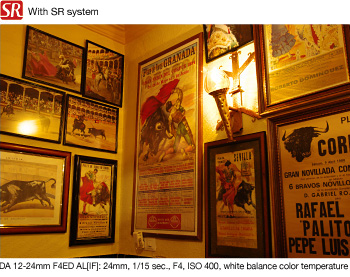 The
natural expressions and unrestrained gestures of your subject — these are the
moments of truth that you can only catch with casual snapshot. The K20D lets
you capture such moments even in the dark without worrying about camera shake,
because its sophisticated SR (Shake Reduction) system built into the body effectively
compensates for camera shake and always assures sharp, fine-detailed images without
the use of a tripod. In fact, it compensates camera shake equivalent to approximately
2.5 to four shutter steps,* so beautiful, blur-free images expressing the atmosphere
of sunset and indoor scenes can be taken with only incident light. This lets
the photographer avoid using the flash or tripod whenever desired. Since the
K20D allows handheld shooting under a wide range of lighting conditions, you
can react swiftly and easily to fleeting, once-in-a-lifetime shutter opportunities.
The
natural expressions and unrestrained gestures of your subject — these are the
moments of truth that you can only catch with casual snapshot. The K20D lets
you capture such moments even in the dark without worrying about camera shake,
because its sophisticated SR (Shake Reduction) system built into the body effectively
compensates for camera shake and always assures sharp, fine-detailed images without
the use of a tripod. In fact, it compensates camera shake equivalent to approximately
2.5 to four shutter steps,* so beautiful, blur-free images expressing the atmosphere
of sunset and indoor scenes can be taken with only incident light. This lets
the photographer avoid using the flash or tripod whenever desired. Since the
K20D allows handheld shooting under a wide range of lighting conditions, you
can react swiftly and easily to fleeting, once-in-a-lifetime shutter opportunities.
* The degree of shake reduction effect may vary, depending on the lens used and/or
the photographic conditions.
Note: Users are advised to turn the SR system off when using the K20D on a tripod.
High-precision compensation of minute shake optimizes the resolving power of the image sensor and PENTAX lens
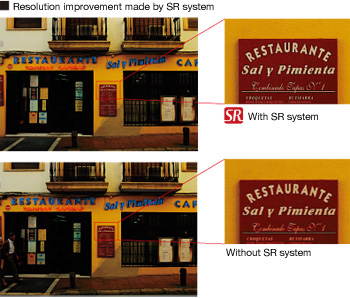 Some
prints may look dull or lack sharpness, even when you didn’t notice these problems
when viewing them on the camera’s LCD monitor. In most cases, these problems
are caused by very minute camera shake. The K20D’s SR system not only performs
superbly in slow-shutter situations, but also works effectively with faster shutter
speeds by compensating an extremely slight level of camera shake that is noticeable
only in large-size prints or magnified screen images. As a result, the exceptional
descriptive power of the smc PENTAX interchangeable lenses and the outstanding
resolving power of the 14.6-megapixel CMOS image sensor are optimized even in
most demanding situations.
Some
prints may look dull or lack sharpness, even when you didn’t notice these problems
when viewing them on the camera’s LCD monitor. In most cases, these problems
are caused by very minute camera shake. The K20D’s SR system not only performs
superbly in slow-shutter situations, but also works effectively with faster shutter
speeds by compensating an extremely slight level of camera shake that is noticeable
only in large-size prints or magnified screen images. As a result, the exceptional
descriptive power of the smc PENTAX interchangeable lenses and the outstanding
resolving power of the 14.6-megapixel CMOS image sensor are optimized even in
most demanding situations.
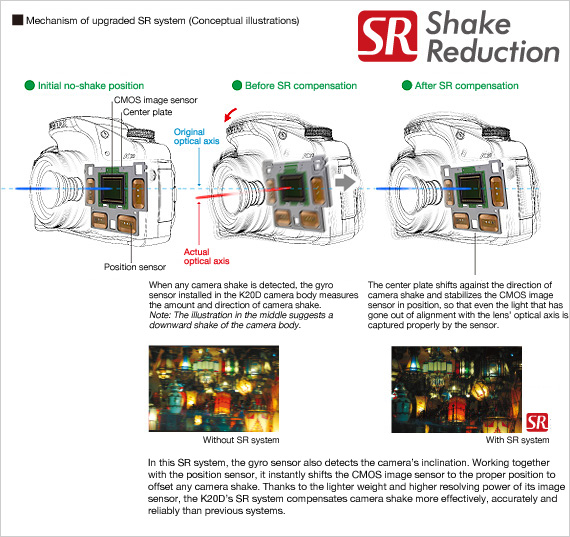
The combination of SR system and super-high ISO sensitivity is the key to instant, simultaneous offsetting of camera shake and subject shake for sharp, crisp images
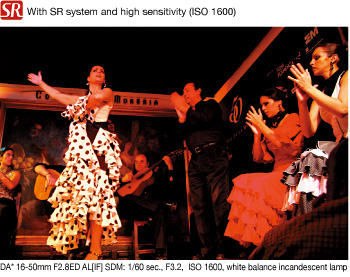 Another
factor that may reduce the sharpness and crispness of your images is subject
shake caused by the subject’s movement during exposure. This problem is normally
solved by a choice of a faster shutter speed. The K20D allows you to raise the
sensitivity as high as ISO 3200 in the standard sensitivity mode (or even to
ISO 6400 in the expanded sensitivity mode, which is selected via a custom function).
By combining the SR system with this super-high sensitivity setting, you can
select an faster shutter speed to freeze fast-moving subjects and preserve them
as sharp, crisp images. Most memorable moments may lie in the dark. The K20D’s
true value becomes more evident under such demanding lighting conditions.
Another
factor that may reduce the sharpness and crispness of your images is subject
shake caused by the subject’s movement during exposure. This problem is normally
solved by a choice of a faster shutter speed. The K20D allows you to raise the
sensitivity as high as ISO 3200 in the standard sensitivity mode (or even to
ISO 6400 in the expanded sensitivity mode, which is selected via a custom function).
By combining the SR system with this super-high sensitivity setting, you can
select an faster shutter speed to freeze fast-moving subjects and preserve them
as sharp, crisp images. Most memorable moments may lie in the dark. The K20D’s
true value becomes more evident under such demanding lighting conditions.
PENTAX-designed SR system is the best solution to camera-shake compensation in any camera system
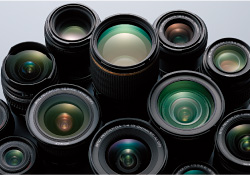 What
is the ideal camera-shake compensation for a digital SLR camera system? PENTAX’s
answer to this question is an image-sensor-shift-type compensation system, because
it extends the benefits of effective camera-shake compensation to all types of
lenses — from wide angle to telephoto. As a result, even owners of old manual-focus
lenses can enjoy this benefit and use their treasured, longtime partners on the
state-of-the-art K20D camera body. Since this system requires no special devices
or mechanisms within the lens body, all new lenses can be developed with the
highest attention to optical performance and descriptive power. Its remarkable
benefits are even extended to unifocal lenses, which have no room for the installation
of corrective optical elements. A wide variety of concept lenses, such as ultra-thin
pancake lenses and super-compact zoom lenses, can be easily developed. In terms
of image quality, operability and system configuration, PENTAX’s in-body SR system
satisfies all the conditions required by an ideal camera-shake compensation system,
and is the symbol of PENTAX’s rational, well-conceived system development approach.
What
is the ideal camera-shake compensation for a digital SLR camera system? PENTAX’s
answer to this question is an image-sensor-shift-type compensation system, because
it extends the benefits of effective camera-shake compensation to all types of
lenses — from wide angle to telephoto. As a result, even owners of old manual-focus
lenses can enjoy this benefit and use their treasured, longtime partners on the
state-of-the-art K20D camera body. Since this system requires no special devices
or mechanisms within the lens body, all new lenses can be developed with the
highest attention to optical performance and descriptive power. Its remarkable
benefits are even extended to unifocal lenses, which have no room for the installation
of corrective optical elements. A wide variety of concept lenses, such as ultra-thin
pancake lenses and super-compact zoom lenses, can be easily developed. In terms
of image quality, operability and system configuration, PENTAX’s in-body SR system
satisfies all the conditions required by an ideal camera-shake compensation system,
and is the symbol of PENTAX’s rational, well-conceived system development approach.


